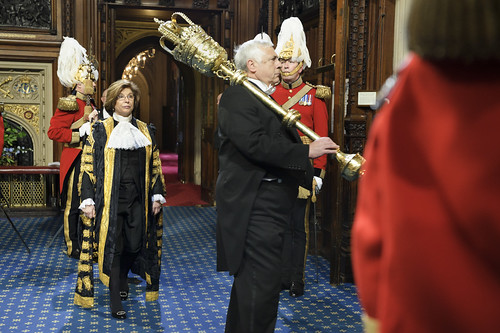One book I read was The Great Palace, by Christopher Jones, about the Houses of Parliament themselves. It was published in 1985 so not up to date, but that didn't matter for my purposes! Some things I learned:
"The Mace, the symbol of Royal authority, must always be present when the House is sitting. Without it, the House is totally powerless."
 |
| "The Lord Speaker, accompanied by the mace and doorkeepers, makes her way to Sovereign’s Entrance to await the arrival of the Queen." Image: Parliamentary copyright/ Catherine Bebbington. |
More on the Mace from Wikipedia.
 |
| "The Serjeant at Arms, Jill Pay, places the mace on the Table to signal that the House is sitting. May 18 2010." Image: Catherine Bebbington. Parliamentary Copyright. |
On the next page:
"The Serjeant-at-Arms[...]is the only person in the Chamber allowed to wear a sword." This doesn't make clear to me whether s/he actually wears a sword--I can't see one in the above picture. (But is that a change since 1985?)
Two pages later:
"The House of Commons snuffbox. It is kept by the Principal Doorkeeper. Any Member may ask for a pinch of snuff before going into the Chamber."
According to Wikipedia, "A floral-scented snuff called 'English Rose' is provided for members of the British House of Commons at public expense due to smoking in the House being banned since 1693. A famous silver communal snuff box kept at the entrance of the House was destroyed in an air raid during World War II with a replacement being subsequently presented to the House by Winston Churchill." (The new box was made from the timber recovered from the damaged Chamber.) Nicholas Fairbairn, an MP until 1995, was known during his tenure for being the only person to actually use the snuff.
I'm not sure the snuff is English Rose anymore, though, because check out this 2010 Freedom of Information request I found! The respondent states, among other things, that "The cost of the snuff is approx £6 per tin and the House has purchased 4 tins in 8 years, the cost is paid from Serjeant at Arms' petty cash. There is no specific company make and the House just purchases it from a local tobacconist," and that "Members who have taken snuff in the past year numbered perhaps less than five, Members taking snuff in the present Parliament has yet to occur."
And guess what: it turns out the US Senate has ceremonial snuffboxes too!
But my very, very favorite is this:
"The House of Commons opera hat. The collapsible top hat which Members must wear if they want to raise a point of order during a division [their word for a vote]."
And there's a little picture of an old top hat sitting on a bench.
I was desperately sad to discover that this custom had been discontinued following a recommendation of the Select Committee on the Modernization of the House of Commons:
"64. At present, if a Member seeks to raise a point of order during a division, he or she must speak 'seated and covered'. In practice this means that an opera hat which is kept at each end of the Chamber has to be produced and passed to the Member concerned. This inevitably takes some time, during which the Member frequently seeks to use some other form of covering such as an Order Paper. This particular practice has almost certainly brought the House into greater ridicule than almost any other, particularly since the advent of television. We do not believe that it can be allowed to continue."
Another beautiful image was provided by Hansard's record of the discussion on the issue:
"We recommend a new procedure for raising points of order during a Division. At present, we have the opera hat, and, although some Members may feel that they look particularly fetching in it, it makes the House of Commons look ridiculous when someone wearing the hat is trying to raise a point of order from a seated position while everyone else is milling around and going to vote."
(Sidenote: If anyone writing historical romance with a political dimension doesn't already know about the online Hansard's, here it is! It is saving my life with things like dates of parliamentary recesses, when bills were proposed, &c.)
Can anyone find a picture of the opera hat? Preferably being worn. My Google-fu is failing me.









.jpg/633px-Microcosm_of_London_Plate_028_-_Custom_House_(colour).jpg)

